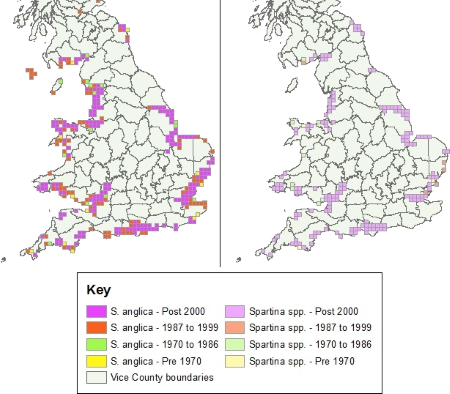 Common cord-grass Spartina anglica is a perennial grass found on mud deposits in saltmarshes. It originated as a hybrid of the native small cord-grass S. maritima and the North American species smooth cord-grass S. alterniflora, but became fertile and subsequently spread across the UK. It is now considered to be an endemic native in the UK, but may be non-native locally where it was planted to support coastal protection and land claim projects. It is also considered to have a detrimental impact on mudflat and saltmarsh biodiversity and processes, but detailed evidence of these impacts is limited.
Common cord-grass Spartina anglica is a perennial grass found on mud deposits in saltmarshes. It originated as a hybrid of the native small cord-grass S. maritima and the North American species smooth cord-grass S. alterniflora, but became fertile and subsequently spread across the UK. It is now considered to be an endemic native in the UK, but may be non-native locally where it was planted to support coastal protection and land claim projects. It is also considered to have a detrimental impact on mudflat and saltmarsh biodiversity and processes, but detailed evidence of these impacts is limited.
Exegesis, working in partnership with NatureBureau, were contracted to undertake an EU LIFE+ supported review of S. anglica as part of Natural England's Improvement Programme for England’s Natura 2000 Sites.
S. anglica has been implicated in a number of impacts on saltmarsh habitats, including increased accretion rates, changed to erosion patterns, reductions in eelgrass Zostera beds and glasswort Salicornia communities, and reduction of areas suitable for bird feeding. We conducted a review of these impacts, which led us to conclude that the overall impact of S. anglica could not clearly be regarded as either positive or negative, as it is hard to separate the impacts caused by S. anglica from those resulting from other processes. For example, causal links between S. anglica and reduction in bird feeding areas were not identified. There is also evidence of S. anglica co-dominating with Salicornia in mixed communities where only S. anglica was known previously, possibly due to a decrease in accretion rates.
We collated recent survey data and species records to assess the extent and distribution of S. anglica. Unfortunately, due the limited coverage of recent survey data very few areas of S. anglica dominated communities could be identified, so the estimate of extent was considered to be a gross underestimate. Recommendations were made to gain a more complete knowledge of the extent of S. anglica using remote sensing and field survey. In contrast, data showing the distribution of S. anglica were more readily available than previously, allowing detailed distribution maps to be created. These showed that the distribution of S. anglica appears to have been relatively stable, having changed little since 1970.
We developed a S. anglica monitoring protocol that aimed to collect information that could be used to determine the extent of S. anglica and to help decide whether management was required. Draft survey forms were tested on sites in the Severn Estuary, Essex coast and North Northumberland Coast, following which improvements were made.
A review of S. anglica control techniques was undertaken, covering physical removal, cutting, grazing, smothering, rotoburying, treatment with herbicides and biological control. This allowed the most effective methods of controlling S. anglica to be identified, but it was noted that any control should be undertaken cautiously and based upon sound evidence, as its removal was likely to result in sediment discharge and potential impacts on designated features. A management decision flow chart was created that aims to help managers of Natura 2000 sites decide where management is most appropriate.
Read the report.
We subsequently undertook a similar review of common cord-grass in Ireland.
Further information from Claire Lush.